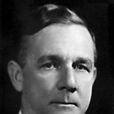基本介紹
- 中文名:喬治·惠普爾
- 外文名:George Hoyt Whipple
- 國籍:美國
- 出生日期:1878年8月28日
- 逝世日期:1976年2月1日
- 性別:男
人物生平,主要成就,
人物生平
George Hoyt Whipple was born on August 28, 1878, in Ashland, New Hampshire, U.S.A., the son of Dr. Ashley Cooper Whipple and his wife Frances Hoyt. His paternal grandfather and his father, both physicians, were born and bred in New Hampshire.
Whipple was educated at Andover Academy and then went to Yale University, where he took his A.B.degree in 1900. Subsequently he went to Johns Hopkins University, where he took his M.D. degree in 1905.
In 1905 he was appointed Assistant in Pathology at the Johns Hopkins Medical School and, although he spent a year as pathologist to the Ancon Hospital, Panama, he remained at Johns Hopkins University until 1914, being successively Assistant, Instructor, Associate and Associate Professor in Pathology.
In 1914 he was appointed Professor of Research Medicine at the University of California Medical School, and Director of the Hooper Foundation for Medical Research at that University, being Dean of the Medical School during the years 1920 and 1921. In 1921 he was appointed Professor of Pathology and Dean of the School of Medicine and Dentistry at the University of Rochester.
Whipple's main researches were concerned with anaemia and the physiology and pathology of the liver. For a year he worked under General William Gorgas and Dr. S. T. Darling on anaemia caused by parasitic infections and especially on the lesions found in the intestinal tract in people suffering from these infections. He also studied the histology of the tissues in patients suffering from blackwater fever.
When he went to Johns Hopkins University as an assistant in the Department of Pathology, Whipple worked under William H. Welch on pigments related to liver necrosis caused by chloroform anaesthesia, his aim being to gather information about repair and regeneration of the liver cells. This problem was studied in the dog, and Whipple found that the liver cells had an almost limitless power of regeneration. He then became interested in jaundice, which is always associated with chloroform poisoning and injury to the liver. He studied the route by which the bile pigments pass into the blood and thus produce jaundice of various parts of the body and he found that the lympathic system was of little importance in transporting them. He then studied, by means of bile fistulas and other means, the bile pigments and their production outside the liver, and in this work he collaborated with C. W. Hooper.
After his appointment at the Hooper Foundation, Whipple continued his work with bile fistulas, and soon found that a better understanding of the production of haemoglobin was needed if the metabolism of bile pigments was to be understood. In collaboration with C. W. Hooper and Mrs. Robscheit-Robbins, he did experiments on short-term anaemia in dogs due to loss of blood, and further work was done on this subject and on diets consisting of liver in relation to the regeneration of blood. In Rochester, however, he decided to use anaemias due to blood loss which were uniformly sustained and were long maintained, and to study the effects on these of various factors in diets added to the rations. This work showed that the most effective addition to the diets was raw liver itself. For this work on the therapeutic value of liver in the treatment of pernicious anaemia he was awarded, together with George R. Minot and William P. Murphy, the Nobel Prize for Physiology or Medicine in 1934.
Whipple has, in addition to the researches just described, worked on tuberculosis, pancreatitis, chloroform poisoning in animals, the metabolism of pigments and iron, the constituents of the bile, and the regeneration of plasma protein, and he has studied protein metabolism by means of lysine labelled with 14C, and also vitamin B12 labelled with 60Co, and its distribution and functions in the body. He has also made studies of the stroma of red blood cells.
Among the many honours and distinctions he received are honorary doctorates of several American Universities as well as of the Universities of Athens and Glasgow; the Popular Science Monthly Gold Medal and Annual Award in 1930 (with Dr. Minot), and the William Wood Gerhard Gold Medal of the Pathological Society of Philadelphia, in 1934.
He is a Trustee of the Rockefeller Foundation. He is also a Corresponding Member of the Association of Physicians in Vienna and of the Royal Society of Physicians in Budapest, and of the European Society of Haematology, and a Foreign Corresponding Member of the British Medical Association. He is an Honorary Member of the Pathological Society of Great Britain and Ireland, and of the American Philosophical Society and the Society of Experimental Biology and Medicine. He was, from 1936-1953, a member of the Board of Scientific Directors of the Rockefeller Institute, a member of the Board of Trustees of this Foundation from 1939-1953, Vice-Chairman of its Board of Trustees from 1953-1960, and in 1960 he was appointed Trustee Emeritus.
In 1914 Whipple married Katherine Ball Waring of Charleston, South Carolina. He has one son George Hoyt (b. 1917) and one daughter Barbara (b. 1921), and seven grandchildren.
From Nobel Lectures, Physiology or Medicine 1922-1941, Elsevier Publishing Company, Amsterdam, 1965
This autobiography/biography was first published in the book series Les Prix Nobel. It was later edited and republished in Nobel Lectures. To cite this document, always state the source as shown above.
George H. Whipple died on February 1, 1976.
主要成就
他的主要研究興趣是膽色素,這與普萊格爾及維蘭德是一樣的,不過他對這問題採取了第三種方向。他想,既然膽色素是血色素在體內形成的,就應當從它的形成著手,找出人體操縱血色素的方法。因此,他在1917年開始一系列的實驗,他給狗放血造成貧血,然後注意觀察新的血紅細胞是如何形成的,他給狗飼以各種飲食,觀察對血紅細胞的形成有什麼效用,發現肝是其中最為有效的一種食物。他這項工作為喬治·理查茲·邁諾特George Richards Minot(1885—1950)及墨菲(William Parry Murphy,1892—1987)成功地治療惡性貧血開闢了道路,因而他與此二人共同獲得1934年的諾貝爾生理學或醫學獎。
羅切斯特大學作為美國最佳大學之一,在該校工作或學習過的著名學者中喬治·惠普爾這位醫學和牙科學院的創始人兼院長因發現貧血病的肝臟療法,於1934年同美國的喬治·邁諾特、威廉·P·墨菲共同獲諾貝爾生理學醫學獎。
喬治·惠普爾先後就讀兩在大名校:分別是耶魯大學、約翰斯·霍普金斯大學,並就職於加利福尼亞大學、羅切斯特大學,還創建了羅徹斯特大學醫學院,任院長

